 |
 |
 |
 |
 |
 |
 |
 |
 |
 |
 |
 |
 |
 |
 |
 |
 |
 |
 |
 |
 |
 |
 |
 |
 |
 |
 |
 |
 |
 |
 |
 |
 |
 |
 |
 |
 |
 |
 |
 |
 |
 |
 |
 |
 |
 |
 |
|
|
THE
AREA
(Pg. 2)
The Area
Pg. 1
The Area
Pg. 2
The Area
Pg. 3
The Area
Pg. 4
The Area
Pg. 5 |
|
|
|
 |
|
|
|
From both Lu Lette and La Rocca there are roads
which wind their way up to Blockhaus at an elevation of 7000 feet.
In the 1800s Blockhaus was the site of a military garrison placed there by
the government of the newly unified Italian state to combat the briganti, many of whom were Abruzzese
partisans who were resisting the unification and who hid in the
mountains. The garrison is long-gone, but near its site is a large
rock outcropping, the Tavola dei Briganti, which bears names and graffiti
chiseled there by the partisans, who left these marks to taunt the
soldiers of the garrison. Among the graffiti is one stating that
under King Victor Emanuel (during whose reign Italy was unified) "the reign of flowers has
become the reign of misery." The Abruzzese were slow to surrender
their independence!
As you travel these roads up to Blockhaus, you
pass through lower pastures, then forest, and finally through the high
pastures where grazing flocks of sheep and goats are guarded by shepherds
and their Abruzzese sheep dogs. The sheep stay on the mountain all
summer. The lower pastures are studded with stone tholoi or capanne.
These dry-stone shepherds' huts are no longer in use, but they are
reminders that the flocks and the pecorino cheese made from their milk
have been a way of life here, together with farming down in the valleys,
for centuries. |
|
|
|
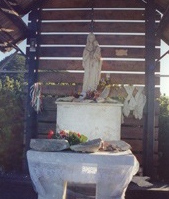 |
|
|
|
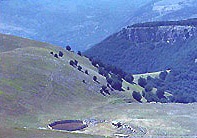 |
|
|
|
|
|
Looking down from Blockhaus onto a
high mountain pasture with a shepherd's hut and the pen in which the sheep
are kept at night. |
|
|
|
|
Statue of the Madonna on top of
Blochaus. |
|
|
|
|
|
|
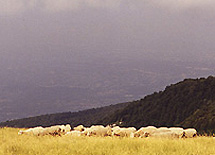 |
|
|
|
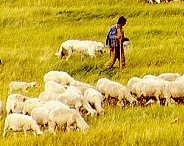 |
|
|
|
Shepherd with his flock and one of
his Abruzzese sheep dogs. There are a number of dogs with each
flock. |
|
|
|
|
Flock on a high mountain pasture on
Blockhaus. |
|
|
|
|
|
|
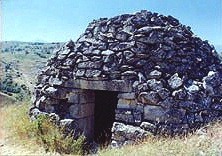 |
|
|
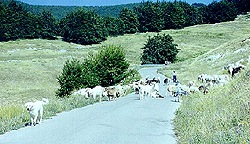 |
|
|
|
Flock on a lower pasture in La
Rocca; Abruzzese sheep dog in front. |
|
|
|
|
|
|
Capanna or shepherd's hut; they were
used mostly in the 1700s and 1800s. |
|
|
|
|
|
 |
|
|
|
After the unification of Italy in 1865, the people
of the Abruzzo region were deeply and negatively impacted by social and
economic changes. The end of the feudal landholding system resulted
in the privatization of land which had formerly been used communally,
which meant that people who could not afford to own land no longer had
access to any. And the family farming that was characteristic of the
region suffered as a result of the deforestation of the mountainsides,
which was done to increase grazing for sheep, but which led to soil
erosion on the lower slopes where crops had been grown. Sadly, as a
result of these and other changes, the agro-pastoral system that had
supported the Abruzzese for centuries failed, and many were so
impoverished that they had no choice but to leave their beautiful homeland
in order to survive. From the late 1800s until about 1915, roughly
twenty per cent of the population of Abruzzo left, seeking other means of
livelihood.
Many people from Lettomanoppello and Roccamorice
emigrated to Canada, the United States, other parts of Europe, South
America and Australia during that period, and afterwards as well.
Now, so many years later, these emigrants and their children and
grandchildren are deeply rooted in their new homelands. But they
have never forgotten their ancestral homes, nor have they lost their pride
in their heritage. We hope that this page will grow, and that it
will play a small part in keeping that memory and heritage alive. If
you have photos, anecdotes, family memories of these places, please share
them with us and help make this website grow! |
|
|
|
 |
|
|
Statue at Roccamorice memorializing those who were
forced to emigrate but who never forgot their
homeland. |
|
|
|
 |
|
|
|
Lu
Lette | La
Rocca | The
Area | Other
Towns | "Stories"
Lu Lette
Surnames | La Rocca
Surnames | Maps |
Family
Nicknames
Organizations &
Events | Scrapbook |
Genealogy
Help | Links
Sign Our
Guestbook | Home |
View Our
Guestbook
*DOWNLOAD LU LETTE AND
LA ROCCA SONGS*
*DIALECT
VERSE ABOUT A LETTESE AND A ROCCOLANO* |
|
|
 |
|
 |
|
|
The Area
Pg. 1 |
|
The Area
Pg. 3 |
|






